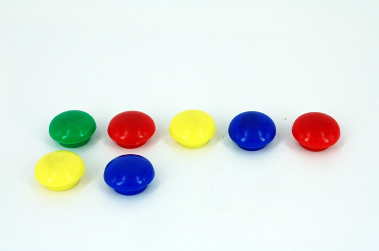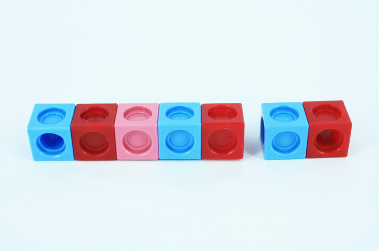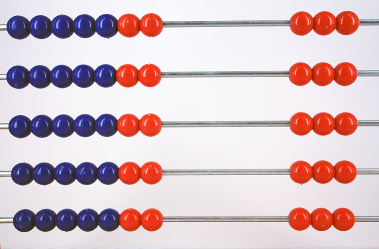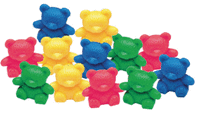Diagnostic questions
There are eight beans under this card and five beans under this card. How many beans are there altogether?
What to notice in the student’s response
Does the student hold up eight fingers and proceed to count them all, “1, 2, 3, 4, 5, 6, 7, 8”, then continue adding using their fingers, “9, 10, 11, 12, 13”?
Deliberate acts of teaching
Materials
- Bears
- Plastic container
- Playing cards
- Abacus
Work on helping the student to understand that a number such as 5 can be viewed as a set, a line of objects, a finger pattern, a number on an abacus, and a number on a tens frame and that when they count out the number, the last number both quantifies and names the set.
Start with a number greater than 5 and add on a set less than 6. Repeat the first number several times before adding the next set. Use several examples to help build the student’s confidence. As the student gains confidence, increase the numbers into the teens.
The following activities will help the student to trust the count
Hidden objects: For a problem such as 8 + 3, ask the student to count out eight bears. Hide the bears under a container. Shake the container, asking “How many bears are in here?” Place three bears alongside the container and say “Three more bears come along, so how many are there altogether?” Encourage the student to hold the 8 in their head and to count the 3 on.
Playing cards: Show the student a card, for example, a 7, and then put the card face down on the table. Turn over another playing card and ask the student to work out how many there are now.
Abacus: Cover half of an abacus lengthways. Move nine beads behind the cover. Ask the student how many beads were moved. Repeat the number and count on four more, moving one bead at a time. Ask the student how many beads are behind the cover now. Remove the cover to show 13 beads.
What to do next if the student is stuck
Give the student practice quantifying numbers by, for example, exploring the “threeness” of 3 or the “fiveness” of 5.
Useful resources include: Exploring 1–5 by Bev Dunbar
BSM, Studies of 5–10: 5-3-8, 6-1-7, 7-1-8, 6-3-5, 7-3-4, 9-1-3
Initiating home-based activities
Encourage parents to find problems for the students to solve within the home. For example, “We have eight plants in the garden, and we are going to plant four more. How many plants will we have altogether?” or “You have 13 marbles, and you give five to your brother. How many marbles do you have left?” Advise parents to get the student to count from the biggest number.
Next teaching steps back in the classroom
Reinforce the development of advanced counting strategies by providing story problems involving a teen number. Increase the number range as the student’s confidence increases by moving across the decades: 37 + 5, 32 – 4, 18 + = 23



